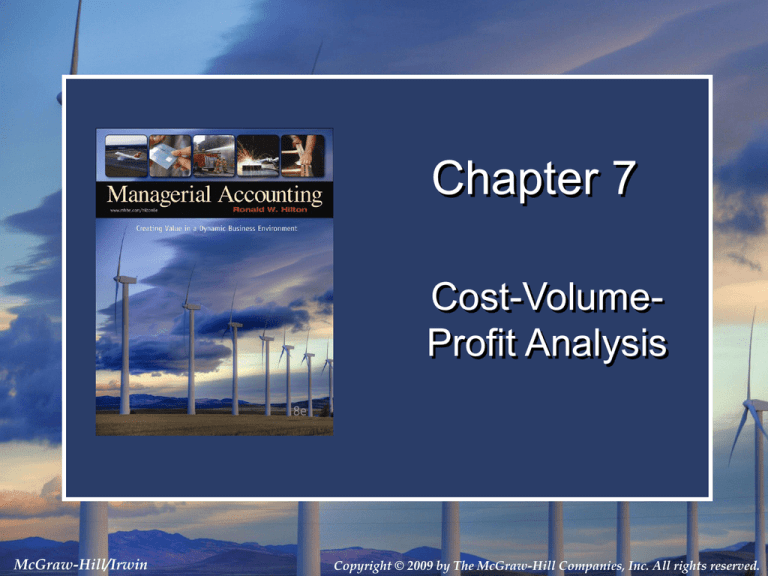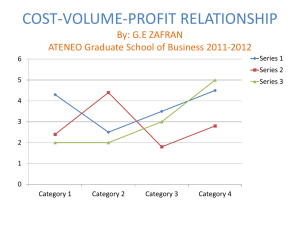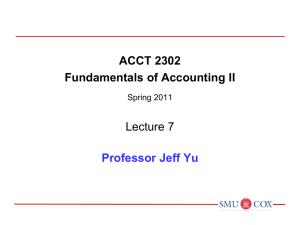
Chapter 7
Cost-VolumeProfit Analysis
McGraw-Hill/Irwin
Copyright © 2009 by The McGraw-Hill Companies, Inc. All rights reserved.
Learning
Objective
1
McGraw-Hill/Irwin
Copyright © 2009 by The McGraw-Hill Companies, Inc. All rights reserved.
The Break-Even Point
The break-even point is the point in the
volume of activity where the organization’s
revenues and expenses are equal.
Sales
$ 250,000
Less: variable expenses 150,000
Contribution margin
100,000
Less: fixed expenses
100,000
Net income
$
-
7-3
Equation Approach
Sales revenue – Variable expenses – Fixed expenses = Profit
Unit
Sales
sales × volume
price in units
Unit
Sales
variable × volume
expense in units
($500 × X) –
($300 × X)
– $80,000 = $0
($200X) – $80,000 = $0
X = 400 surf boards
7-4
Learning
Objective
2
McGraw-Hill/Irwin
Copyright © 2009 by The McGraw-Hill Companies, Inc. All rights reserved.
Contribution-Margin Approach
Consider the following information
developed by the accountant at Curl, Inc.:
For each additional surf board sold,
Curl generates $200 in contribution
margin.
Sales (500 surf boards)
Less: variable expenses
Contribution margin
Less: fixed expenses
Net income
Total
$250,000
150,000
$100,000
80,000
$ 20,000
Per Unit
$
500
300
$
200
Percent
100%
60%
40%
7-6
Contribution-Margin Approach
Fixed expenses
Break-even point
=
Unit contribution margin
(in units)
Sales (500 surf boards)
Less: variable expenses
Contribution margin
Less: fixed expenses
Net income
$80,000
$200
Total
$250,000
150,000
$100,000
80,000
$ 20,000
Per Unit
$
500
300
$
200
Percent
100%
60%
40%
= 400 surf boards
7-7
Contribution-Margin Approach
Here is the proof!
Sales (400 surf boards)
Less: variable expenses
Contribution margin
Less: fixed expenses
Net income
400 × $500 = $200,000
Total
$200,000
120,000
$ 80,000
80,000
$
-
Per Unit
$
500
300
$
200
Percent
100%
60%
40%
400 × $300 = $120,000
7-8
Contribution Margin Ratio
Calculate the break-even point in sales dollars
rather than units by using the contribution margin
ratio.
Contribution margin
Sales
Fixed expense
CM Ratio
= CM
Ratio
Break-even point
=
(in sales dollars)
7-9
Contribution Margin Ratio
Sales (400 surf boards)
Less: variable expenses
Contribution margin
Less: fixed expenses
Net income
$80,000
40%
Total
$200,000
120,000
$ 80,000
80,000
$
-
=
Per Unit
$
500
300
$
200
Percent
100%
60%
40%
$200,000 sales
7-10
Learning
Objective
3
McGraw-Hill/Irwin
Copyright © 2009 by The McGraw-Hill Companies, Inc. All rights reserved.
Graphing Cost-Volume-Profit
Relationships
Viewing CVP relationships in a graph gives
managers a perspective that can be obtained in
no other way.
Consider the following information for Curl, Inc.:
300 units
Sales
$ 150,000
Less: variable expenses
90,000
Contribution margin
$ 60,000
Less: fixed expenses
80,000
Net income (loss)
$ (20,000)
400 units
$ 200,000
120,000
$ 80,000
80,000
$
-
500 units
$ 250,000
150,000
$ 100,000
80,000
$ 20,000
7-12
Cost-Volume-Profit Graph
450,000
400,000
350,000
Dollars
300,000
250,000
200,000
150,000
Fixed expenses
100,000
50,000
100
200
300
400
Units
500
600
700
800
7-13
Cost-Volume-Profit Graph
450,000
400,000
350,000
Dollars
300,000
250,000
200,000
150,000
Fixed expenses
100,000
50,000
100
200
300
400
Units
500
600
700
800
7-14
Cost-Volume-Profit Graph
450,000
400,000
350,000
Dollars
300,000
250,000
200,000
150,000
Fixed expenses
100,000
50,000
100
200
300
400
Units
500
600
700
800
7-15
Cost-Volume-Profit Graph
450,000
400,000
350,000
Dollars
300,000
250,000
200,000
150,000
Fixed expenses
100,000
50,000
100
200
300
400
Units
500
600
700
800
7-16
Cost-Volume-Profit Graph
450,000
400,000
350,000
Dollars
300,000
Break-even
point
250,000
200,000
150,000
Fixed expenses
100,000
50,000
100
200
300
400
Units
500
600
700
800
7-17
Profit-Volume Graph
Some managers like the profit-volume
graph because it focuses on profits and volume.
100,000
80,000
60,000
Break-even
point
Profit
40,000
20,000
0
(20,000)
`
100
200
300
400
Units
500
600
700
(40,000)
(60,000)
7-18
Learning
Objective
4
McGraw-Hill/Irwin
Copyright © 2009 by The McGraw-Hill Companies, Inc. All rights reserved.
Target Net Profit
We can determine the number of surfboards
that Curl must sell to earn a profit of $100,000
using the contribution margin approach.
Fixed expenses + Target profit
Unit contribution margin
$80,000 + $100,000
$200
=
Units sold to earn
the target profit
= 900 surf boards
7-20
Equation Approach
Sales revenue – Variable expenses – Fixed expenses = Profit
($500 × X) –
($300 × X) – $80,000 = $100,000
($200X) = $180,000
X = 900 surf boards
7-21
Applying CVP Analysis
Safety Margin
• The difference between budgeted sales
revenue and break-even sales revenue.
• The amount by which sales can drop before
losses begin to be incurred.
7-22
Safety Margin
Curl, Inc. has a break-even point of $200,000.
If actual sales are $250,000, the safety margin is
$50,000 or 100 surf boards.
Sales
Less: variable expenses
Contribution margin
Less: fixed expenses
Net income
Break-even
sales
400 units
$ 200,000
120,000
80,000
80,000
$
-
Actual sales
500 units
$ 250,000
150,000
100,000
80,000
$
20,000
7-23
Changes in Fixed Costs
• Curl is currently selling 500 surfboards per
year.
• The owner believes that an increase of
$10,000 in the annual advertising budget,
would increase sales to 540 units.
Should the company increase the advertising
budget?
7-24
Changes in Fixed Costs
Current
Sales
(500 Boards)
Sales
$
250,000
Less: variable expenses
150,000
Contribution margin
$
100,000
Less: fixed expenses
80,000
Net income
$
20,000
Proposed
Sales
(540 Boards)
$
270,000
162,000
$
108,000
90,000
$
18,000
540 units × $500 per unit = $270,000
$80,000 + $10,000 advertising = $90,000
7-25
Changes in Fixed Costs
Current
Sales will increase by
Sales
$20,000, but net income
(500 Boards)
decreased by $2,000.
Sales
$
250,000
Less: variable expenses
150,000
Contribution margin
$
100,000
Less: fixed expenses
80,000
Net income
$
20,000
Proposed
Sales
(540 Boards)
$
270,000
162,000
$
108,000
90,000
$
18,000
7-26
Changes in Unit
Contribution Margin
Because of increases in cost of raw materials,
Curl’s variable cost per unit has increased
from $300 to $310 per surfboard. With no
change in selling price per unit, what will be
the new break-even point?
($500 × X) –
($310 × X) – $80,000 = $0
X = 422 units (rounded)
7-27
Changes in Unit
Contribution Margin
Suppose Curl, Inc. increases the price of
each surfboard to $550. With no change
in variable cost per unit, what will be the
new break-even point?
($550 × X) –
($300 × X) – $80,000 = $0
X = 320 units
7-28
Predicting Profit Given Expected
Volume
Given:
Given:
Fixed expenses
Unit contribution margin
Target net profit
Fixed expenses
Unit contribution margin
Expected sales volume
Find: {req’d sales volume}
Find: {expected profit}
7-29
Predicting Profit Given
Expected Volume
In the coming year, Curl’s owner expects to sell
525 surfboards. The unit contribution margin is
expected to be $190, and fixed costs are
expected to increase to $90,000.
Total contribution
-
Fixed cost = Profit
($190 × 525) – $90,000 = X
X = $99,750 – $90,000
X = $9,750 profit
7-30
Learning
Objective
5
McGraw-Hill/Irwin
Copyright © 2009 by The McGraw-Hill Companies, Inc. All rights reserved.
CVP Analysis with Multiple
Products
For a company with more than one product,
sales mix is the relative combination in which a
company’s products are sold.
Different products have different selling prices,
cost structures, and contribution margins.
Let’s assume Curl sells surfboards and sail
boards and see how we deal with breakeven analysis.
7-32
CVP Analysis with Multiple
Products
Curl provides us with the following
information:
Unit
Unit
Number
Description
Surfboards
Sailboards
Total sold
Selling Variable Contribution
of
Price
Cost
Margin
Boards
$
500 $ 300 $
200
500
1,000
450
550
300
800
Number
Description of Boards
Surfboards
500
Sailboards
300
Total sold
800
% of
Total
62.5% (500 ÷ 800)
37.5% (300 ÷ 800)
100.0%
7-33
CVP Analysis with Multiple
Products
Weighted-average unit contribution margin
Contribution
Weighted
Description
Margin
% of Total Contribution
Surfboards $
200
62.5% $
125.00
Sailboards
550
37.5%
206.25
Weighted-average contribution margin $
331.25
$200 × 62.5%
$550 × 37.5%
7-34
CVP Analysis with Multiple
Products
Break-even point
Break-even
Fixed expenses
=
point
Weighted-average unit contribution margin
Break-even
=
point
$170,000
$331.25
Break-even
= 514 combined unit sales
point
7-35
CVP Analysis with Multiple
Products
Break-even point
Break-even
point
Description
Surfboards
Sailboards
Total units
=
514 combined unit sales
Breakeven
Sales
514
514
% of
Individual
Total
Sales
62.5%
321
37.5%
193
514
7-36
Learning
Objective
6
McGraw-Hill/Irwin
Copyright © 2009 by The McGraw-Hill Companies, Inc. All rights reserved.
Assumptions Underlying
CVP Analysis
1. Selling price is constant throughout
the entire relevant range.
2. Costs are linear over the relevant
range.
3. In multi-product companies, the
sales mix is constant.
4. In manufacturing firms, inventories
do not change (units produced =
units sold).
7-38
Learning
Objective
7
McGraw-Hill/Irwin
Copyright © 2009 by The McGraw-Hill Companies, Inc. All rights reserved.
CVP Relationships and
the Income Statement
A. Traditional Format
ACCUTIME COMPANY
Income Statement
For the Year Ended December 31, 20x1
Sales
Less:
Gross margin
Less: Operating expenses:
Selling expenses
Administrative expenses
Net income
$500,000
380,000
$120,000
$35,000
35,000
70,000
$50,000
7-40
CVP Relationships and
the Income Statement
B. Contribution Format
ACCUTIME COMPANY
Income Statement
For the Year Ended December 31, 20x1
Sales
Less: Variable expenses:
Variable manufacturing
Variable selling
Variable administrative
Contribution margin
Less: Fixed expenses:
Fixed manufacturing
Fixed selling
Fixed administrative
Net income
$500,000
$280,000
15,000
5,000
$100,000
20,000
30,000
300,000
$200,000
150,000
$50,000
7-41
Learning
Objective
8
McGraw-Hill/Irwin
Copyright © 2009 by The McGraw-Hill Companies, Inc. All rights reserved.
Cost Structure and Operating
Leverage
• The cost structure of an organization is the
relative proportion of its fixed and variable
costs.
• Operating leverage is . . .
– the extent to which an organization uses fixed
costs in its cost structure.
– greatest in companies that have a high
proportion of fixed costs in relation to
variable costs.
7-43
Measuring Operating Leverage
Operating leverage
factor
=
Contribution margin
Net income
Sales
Less: variable expenses
Contribution margin
Less: fixed expenses
Net income
$100,000
$20,000
Actual sales
500 Board
$ 250,000
150,000
100,000
80,000
$
20,000
= 5
7-44
Measuring Operating Leverage
A measure of how a percentage change in
sales will affect profits. If Curl increases its
sales by 10%, what will be the percentage
increase in net income?
Percent increase in sales
Operating leverage factor ×
Percent increase in profits
10%
5
50%
7-45
Measuring Operating Leverage
A firm with proportionately high fixed costs has
relatively high operating leverage On the other
hand, a firm with high operating leverage has a
relatively high break-even point.
7-46
Learning
Objective
9
McGraw-Hill/Irwin
Copyright © 2009 by The McGraw-Hill Companies, Inc. All rights reserved.
CVP Analysis, Activity-Based Costing,
and Advanced Manufacturing Systems
An activity-based costing system can provide
a much more complete picture of costvolume-profit relationships and thus provide
better information to managers.
Break-even =
Fixed costs
point
Unit contribution margin
7-48
Learning
Objective
10
McGraw-Hill/Irwin
Copyright © 2009 by The McGraw-Hill Companies, Inc. All rights reserved.
A Move Toward JIT and
Flexible Manufacturing
Overhead costs like setup, inspection, and material
handling are fixed with respect to sales volume,
but they are not fixed with respect to other cost
drivers.
This is the fundamental distinction between a
traditional CVP analysis and an activity-based
costing CVP analysis.
7-50
Learning
Objective
11
McGraw-Hill/Irwin
Copyright © 2009 by The McGraw-Hill Companies, Inc. All rights reserved.
Effect of Income Taxes
Income taxes affect a company’s
CVP relationships. To earn a
particular after-tax net income, a
greater before-tax income will be
required.
Before-tax
Target after-tax net income
=
net income
1 - t
7-52
End of Chapter 7
We made
it!
7-53









